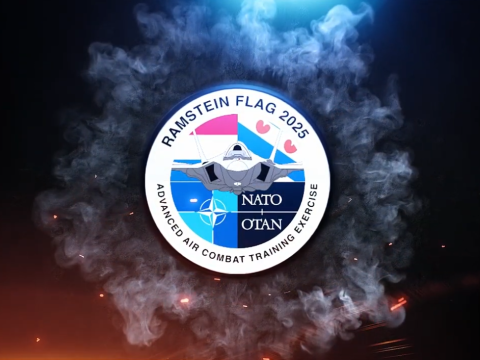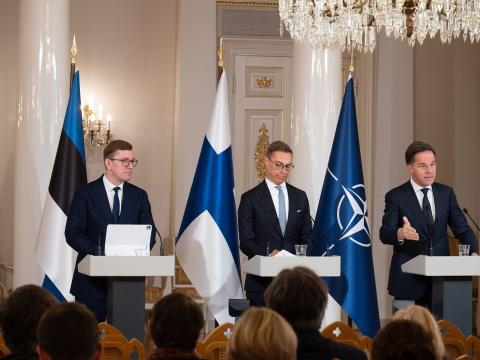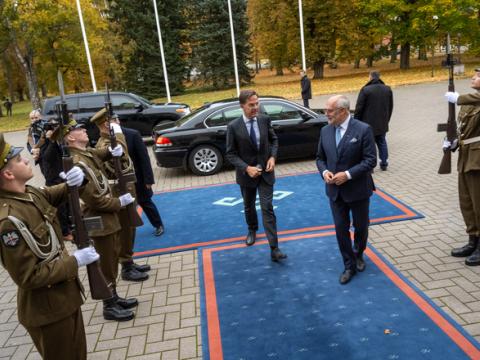NATO Support Agency Continues Evolution
NATO recently consolidated three support and acquisition agencies into one to create effectiveness, improve efficiencies and increase savings. The organization will continue to evolve as the NATO mission transforms, including changes expected following the withdrawal from the war zone in Afghanistan.
The NATO Support Agency (NSPA), Capellen, Luxembourg, was officially established on July 1 under the leadership of Rear Adm. Michael Lyden, USN, (Ret.), who will serve as the general manager. The NSPA combines three previous organizations, the NATO Maintenance and Supply Agency, the NATO Airlift Management Agency and the Central Europe Pipeline Management Agency. The NSPA is a fully customer-funded organization, operating on a no-profit/no-loss basis. It focuses on providing integrated multinational support solutions for its stakeholders.
The support agency’s written mission is to provide responsive, effective and cost-efficient logistics support services for systems and operations. It is designed to provide needed assistance in times of peace, crisis and war to the NATO member nations, the NATO military authorities and partner nations, both individually and collectively. It also aims to maximize the ability and flexibility of armed forces, contingents and other relevant organizations to execute their core missions.
Among other tasks, the mission includes in-service support of weapons systems, as well as communications and electronics systems. “We do operational logistics and real-life support, like running some of the base functions in Afghanistan. We do fuel work. We do airlift. A big piece of our mission is geared toward the current mission in Afghanistan,” Adm. Lyden says.
While focused on short-term goals associated with the consolidation itself, the admiral looks forward and sees the agency’s mission changing once the combat troops return from Afghanistan in 2014. “We’ll have to see how our current capabilities over there match what will be required during the stabilization, reconstruction and training stage once the future NATO mission in Afghanistan is clear. That part of the mission needs to evolve,” he adds.
He asserts that NATO can adapt to shifting missions and requirements fairly rapidly when necessary. “A large proportion of our business is supporting those bases in Afghanistan. That was a capability that largely didn’t exist seven years ago. One of our challenges will be discerning what’s next, particularly post-2014 in Afghanistan,” Adm. Lyden says.
The base support has included constructing command centers, barracks and medical facilities and extending runways. “Wherever they have a mission to build a structure, we’re the integrator that helps execute and supervise the contract,” he adds.
Agency support could include the Allied Ground Surveillance (AGS) system, which could follow the model provided by the NSPA’s legacy agencies for the NATO Airborne Early Warning and Control (AEW&C) program. “With the NATO AEW&C, they’ve done inventory management and the spares support for the operations. We could perform that similar support for any of the new weapon systems that come along,” Adm. Lyden says. “And I point to AGS as the next big one that’s coming into NATO.
“We’ve got a 20-year track record with the NATO AEW&C, and that’s the sort of service we would offer to any of the new capabilities that come out,” the admiral proposes. He adds that it is critical for a support agency to be involved in a program from the beginning because up to 80 percent of a system’s life cycle costs are established in the early stages. “It’s important to get in there as early as possible because we can provide a better product and a better value or sustainment strategy for later on in the life cycle,” he says.
The NATO AEW&C system is known as NATO’s eye in the sky. It is based on the Boeing E-3A Airborne Warning and Control System and is touted by NATO officials as an example of what the allied nations can accomplish by pooling resources. The system provides quick-reaction surveillance and command and control management for tactical and defensive missions, including detection, identification, tracking and interception of hostile aircraft operating at low altitudes over all terrain.
The AGS system, on the other hand, is an unmanned aerial vehicle using Northrop Grumman’s Global Hawk Block 40. NATO is acquiring AGS to give commanders a comprehensive picture of the situation on the ground. The alliance’s recent operations in Libya demonstrated the necessity for an AGS capability, NATO officials say. Thirteen NATO allies—Bulgaria, Czech Republic, Estonia, Germany, Italy, Latvia, Lithuania, Luxembourg, Norway, Romania, Slovakia, Slovenia and the United States—will acquire five systems and the associated command and control base stations, and NATO then will maintain and operate the AGS on behalf of all 28 allies.
In addition, the United Kingdom will contribute the Sentinel, and France will add the future Heron TP to complement the Global Hawks. Those two systems will be national contributions in kind, partly replacing financial contributions from those two allies. AGS is scheduled for fielding in the 2015-2017 time frame.
Pooling resources, as the allies have done for the E-3A and are doing for AGS, is a key component of the NSPA and NATO strategy as nations face ever-tightening defense budgets. “We have leverage when we can combine the aspirations or ambitions of several nations or partners for economies of scale. We can integrate things at a larger level and give some partners capabilities that they wouldn’t be able to access on their own,” Adm. Lyden points out.
The NSPA cannot take a support role for granted, however, the admiral warns. “We’ve got a lot of competition out there—folks who can do what we do, whether it be in the nations themselves or other organizations. We want to be that premier integrated logistics and services provider team,” he emphasizes.
Adm. Lyden began his tenure with a vision for “smart support” and a 100-day plan. The 100-day plan aims to foster greater effectiveness, efficiencies and savings and takes the agency into 2013 for planning and business continuity. The smart support concept aligns the NSPA’s goals with NATO’s overall Smart Defence strategy of spending less to maintain current capabilities and freeing up funding for new capabilities. “We want to be a key enabler of smart defense. We’re going to link together NATO’s logistics capabilities, which are separated right now. We’ll put them together in this network of integrated solutions in the future, rather than the customers or warfighters or nations having to get different pieces from different agencies,” Adm. Lyden declares.
The benefits for the warfighters, he says, are effectiveness, efficiency and savings. “To me, when you talk about what’s important, effectiveness is really it. I define effectiveness as providing the capabilities that the nations and NATO partners need now and in the future. That’s effectiveness to me,” he stresses.
The admiral explains that he has worked closely with the other agencies, especially the new Communications and Information Agency, and he vows that he will continue to do so. “The relationship is absolutely interdependent, and it is essential that we remain shoulder-to-shoulder. The warfighter out there needs both of us together and needs us to coordinate as much as we can,” he says.




Comments